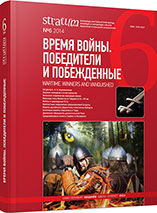Боевые полумаски Восточной Европы в свете последних находок и новых исследований
Battle Half-masks of Eastern Europe in Light of Recent Findings and New Research
Author(s): Sergei Yu. Kainov, Yuriy A. KuleshovSubject(s): History, Archaeology, Military history, Middle Ages, 13th to 14th Centuries
Published by: Издательский дом Stratum, Университет «Высшая антропологическая школа»
Keywords: Eastern Europe; Rus'; battle half-masks; weapons and armour; helmet
Summary/Abstract: The paper focuses on the recently found half-mask that was discovered near the village of Dibrovo (Donetsk reg., Ukraine). Most likely, this half-mask comes from a nomad burial, which also yielded a stirrup, a flint and a knife. The specific burial ritual (with armor placed into the grave) that came into practice in South-Rus’ steppes after the Mongol invasion allows us to date this burial back to as early as the middle of the 13th century A. D. The half-mask found while excavating the stronghold of Old Rus’ town Vschizh (Bryansk reg., Russia) is also carefully considered within the framework of the paper. The report confirmed the presupposed dating of the half-mask by the 12th century, which allows us to challenge the hypothesis about expansion of this protective element after the Mongol invasion. It might be crucial to point out that due to the restoration and the X-ray fluorescence analysis, the method of coating became clear — amalgamation by silver and gold covered with a net of lines. In the conclusion of the paper, after consideration of all the findings of half-masks known for today, on the basis of their morphological peculiarities and chronology, the authors put forward a hypothesis about existence of at least two regions that produced half-masks.
Journal: Stratum plus. Археология и культурная антропология
- Issue Year: 2014
- Issue No: 6
- Page Range: 83-98
- Page Count: 16
- Language: Russian

